- Home
- entertainment
- news
- 'The Fall of the House of Usher' production designer reveals 7 of her favorite on-set secrets and Easter eggs
'The Fall of the House of Usher' production designer reveals 7 of her favorite on-set secrets and Easter eggs
Eammon Jacobs,Caralynn Matassa

- Mike Flanagan's "The Fall of the House of Usher" is inspired by the work of Edgar Allan Poe.
- The series is packed with Poe references and Easter eggs.
"The Fall of the House of Usher" is Mike Flanagan's latest horror series on Netflix, following up his earlier acclaimed shows "The Haunting of Hill House" and "Midnight Mass." And like his previous work for the streaming service, Flanagan's gruesome new show is packed with details for eagle-eyed viewers to find.
Since the show is inspired by the short stories, novels, and poems by Edgar Allan Poe, Flanagan has hidden a number of references to the gothic author's work in each episode.
But when speaking to Insider, production designer Laurin Kelsey pointed out even more details that audiences might have missed when watching "The Fall of the House of Usher."
All the Usher kids were assigned different colors that represent them, and those colors were incorporated into their sets.
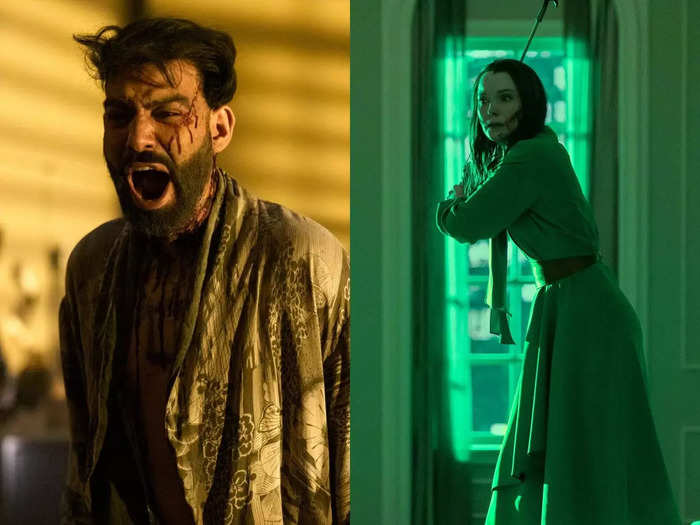
Each of the Usher children has their own color, woven throughout their respective episode, that makes them distinct from the rest.
"Perry was red, Camille is silver, Victorine is orange, Leo is yellow, Tamerlane is green, Frederick is blue," Kelsey tells Insider.
Roderick (Bruce Greenwood) and Madeline (Mary McDonnell) also have assigned colors — gold and purple, respectively. "Together they're kind of a gold-purple combo, which is the Fortunato theme," Kelsey explains.
Each character's home reflected the type of person they are.

The Usher family is incredibly wealthy, thanks to Roderick and Madeline taking over Fortunato, and so unsurprisingly, all the kids have pretty expensive homes. Kelsey says that their homes were dictated by the tpe of person each character was.
"It was sort of like a process of starting with, 'Okay, are they in an apartment or a house?' Those who are in houses are over here, those who are in apartments are over here," she tells Insider. "And then within the apartments, what style of apartment can we give them, and how can we make them different?"
Kelsey used the examples of Camille L'Espanaye (Kate Siegel), Tamerlane Usher (Samantha Sloyan), and Perry Usher (Sauriyan Sapkota) and pointed out how even though they each lived in an apartment, their apartments were vastly different in accordance with their personalities.
"Camille is really hard-lined, hard-edged, modern. But Tamerlane's got a bit of an Upper West Side classy kind of feel so she can have more moldings," Kelsey says.
The youngest Usher, meanwhile, had an extremely millennial abode. "Perry's the young, kind of obnoxious one, and he's got more tech and more modern millennial kind of accessories," she explained.
"Breaking down those kind of differences was what I leaned into because my main concern was that they might all feel like they live in the same apartment building," she jokes.
Eliza Usher's house was a blend of the 1950s and the 1800s, to pay homage to the original Poe story.
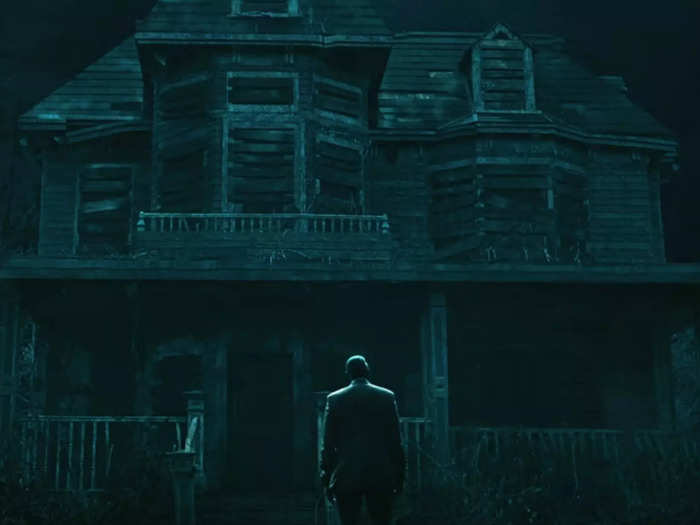
One of the most prominent sets in the series is the house that Roderick and Madeline were raised in by their mother, Eliza Usher (Annabeth Gish). According to Kelsey, this was her favorite set in the show, but she had a difficult task bringing it to the screen.
In Poe's original story, the titular House of Usher is a gothic, Victorian mansion on a hill. But the Netflix show's story starts in the 1950s, so she had to find a way to bring those two seemingly disparate styles together.
"But the more I kind of explored, the more I thought, 'Well if it's the 1950s, those homes weren't necessarily character homes all over North America yet. They were kind of just the old house down the street,'" Kelsey said.
"So something built in 1890s could have the gothic touches and have the elements that we needed to honor the original story," she continued. "But then we could fit it into this suburban world where she doesn't have a ton of money. And that's why she has the oldest house on the street, and that's why things get a little rundown a little quicker."
The front door and the sitting room were designed with the ghosts in mind.
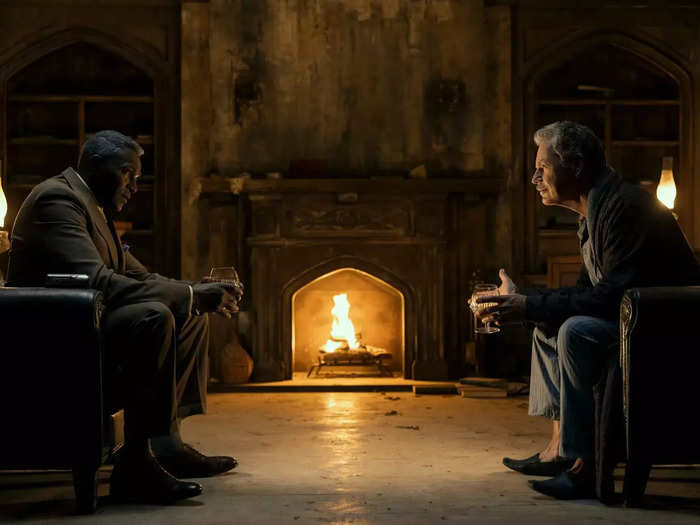
The series' frame story sees Roderick telling Auguste Dupin (Carl Lumbly) exactly what happened to the family, and why they all made the decisions that they did.
But Roderick is haunted by the ghosts of his dead family members during their lengthy conversation, and Kelsey says the design of the sitting room in those scenes (previously the dining room in the 1950s scenes) was specifically made to accomodate those jump scares.
"I really love the relationship of the front door and what becomes the sitting room for the conversation," she explained. "Because it needed to be fairly open, but it also needed to provide a lot of opportunities for the ghosts to step in and out or the hallucinations or however you want to think of it."
"There was a lot of work to be done because character homes are often very closed in that time period, a lot of separate rooms," the production designer added. "So finding something that felt right for the period, but allowed for everything that needed to take place, I think that came across well. I was happy with how that came out."
The Usher home's street address is the year Edgar Allan Poe died.
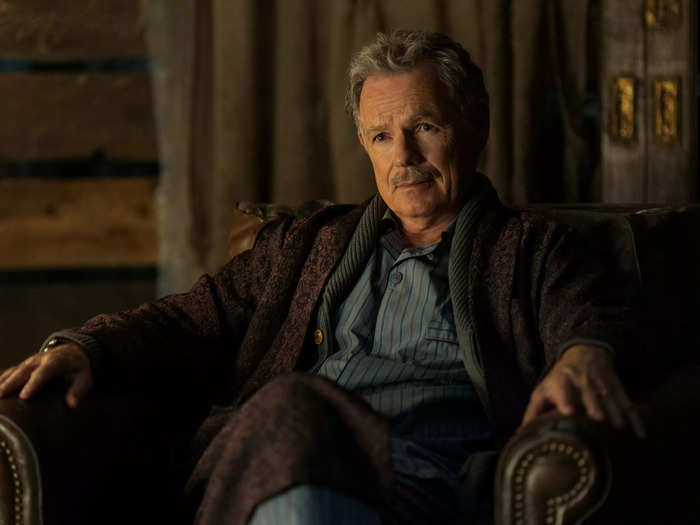
The nods to Edgar Allan Poe go much deeper than just literary references. The street address of Roderick and Madeline's childhood home — 1849 — is actually the year that the writer died, Kelsey pointed out.
"There's so much Poe in the script to begin with. I started with the script, then I brought in Poe in the architecture where I could, or in the environments where I could," Kelsey said. "And then we kind of started to have fun with that last layer."
Donald Trump graffiti inspired a "Masque of the Red Death" design choice.
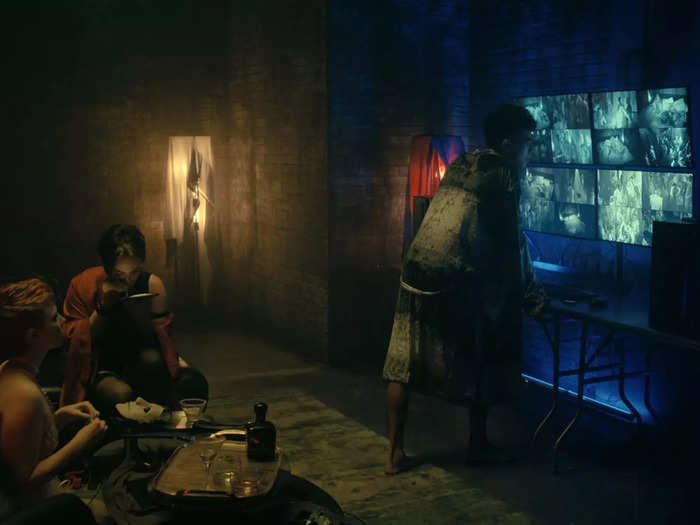
Kelsey also revealed that there's some hidden graffiti art in episode two, "The Masque of the Red Death," that audiences might not spot. It's in Perry's monitor room, where he's surveilling the whole orgy to get blackmail footage of the attendees. She said that in the original script, there was a bathroom where Perry had a conversation.
In the set, Kelsey spotted some graffiti of Donald Trump, and she reworked it to suit the ominous theme of the episode.
"On the wall behind them are a couple mirrors hanging off the wall and old sinks and the outlines of the bathroom stalls on the floor. In between the mirrors, I'd seen this graffiti. It was actually Trump-related graffiti at the time," she said. "It was just some big words scrolled across the wall and then a picture of his face."
The production designer put a quote from Poe's story in graffiti behind the mirrors, but she says it's hard to spot in the episode.
"I took my favorite section of 'The Masque of the Red Death,' which is obviously the story for Perry, and just put that paragraph across the wall behind the mirrors as if it had been graffitied over time, like an old graffiti bathroom," Kelsey revealed. "But I don't think we really see that angle very much, so I think maybe that part is harder for people to spot."
Verna's bar was designed to focus on Roderick and Madeline.
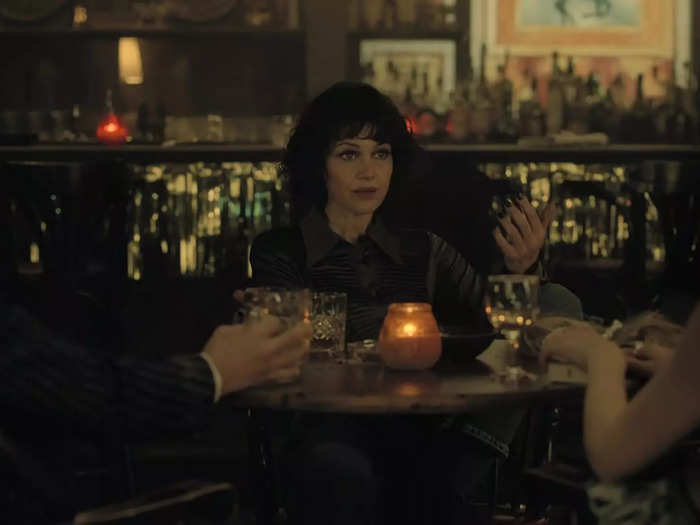
As the final episodes make clear, Roderick and Madeline's success is all thanks to the deal they make with Verna — they get fame and fortune, but the future generations of Ushers pay the gruesome price. The siblings make that bargain in the ominously gloomy bar they stumble into on New Year's Eve in 1979.
That set is filled with hidden details, like the stained glass behind the bar with images of a black cats and a raven sitting on a skull. But Kelsey said she also designed the bar to encompass all the different sides of Verna: "Not only does she feel like death or the devil, but she's bringing everyone to a moral reckoning in a way. So she's not just one thing. I think the bar had to be sort of neutral to cover all the different sides of Verna."
She also explained that the color scheme of the venue is combination of Roderick and Madeline's signature shades, because this is their test: "I thought it was fun to play into the purples, maroons, and golds a little bit of Roderick and Madeline, like the bar was invented just for them."
The production designer also pointed out that it's open for interpretation over whether it's Verna's bar, or the Ushers' bar.
"There are a few small touches over the entry door," Kelsey said. "There's stained-glass that has a Gothic V on it. A Gothic V and a Gothic U look very much the same, so you can almost say, is it the Usher bar or is it the Verna bar? We don't know."
Popular Right Now
Popular Keywords
Advertisement